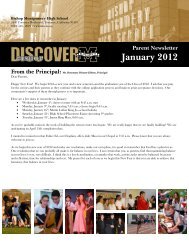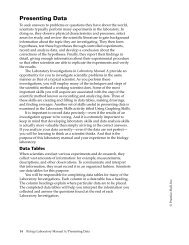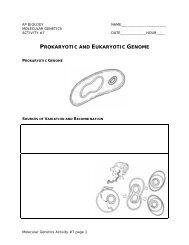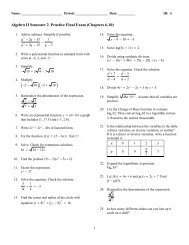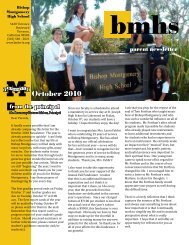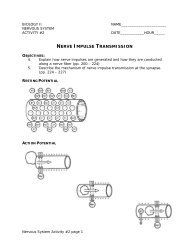Mesopotamia Powerpoint
Mesopotamia Powerpoint
Mesopotamia Powerpoint
You also want an ePaper? Increase the reach of your titles
YUMPU automatically turns print PDFs into web optimized ePapers that Google loves.
<strong>Mesopotamia</strong><br />
The Land Between Two Rivers
Indo-European Migrations: 4m-<br />
2m BCE<br />
The Middle East: “The Crossroads of Three
The Ancient Fertile Crescent<br />
Area<br />
The Middle East: “The Cradle of Civilization”
Location of <strong>Mesopotamia</strong><br />
● “The Land Between Two Rivers”: The Tigris and<br />
Euphrates<br />
● Empires: Sumeria followed by Akad then Assur (Assyria)
Sumerian<br />
Civilization<br />
●AGRICULTURAL REVOLUTION.-<br />
Nomadic herders settled in the<br />
Southern part of <strong>Mesopotamia</strong> and<br />
gradually changed the farming way of<br />
life<br />
●IRRIGATION- use of canals and<br />
waterways to bring water to land.<br />
They built dams and dikes to keep<br />
the rivers from flooding their fields.<br />
●The farming villages emerged along<br />
the river and grew into 12 city-states
Sites of <strong>Mesopotamia</strong><br />
● This map shows Eridu Ur and<br />
Uruk in south in Sumer<br />
●<br />
● Babylonia (Babilonia) to the<br />
northwest<br />
● Home of the lawgiver<br />
Hammurabi
Uruk and Vicinity: Trade<br />
● Resource poor itself, Sumeria<br />
relied on trade<br />
● Main routes: the rivers<br />
(especially the Euphrates)<br />
and overland east-west<br />
● Products imported<br />
● Persian Gulf<br />
● Precious metals and stone:<br />
gold, silver, carnelian, lapus<br />
lazuli, onyx, alabaster<br />
● Textiles, skins, and ivory<br />
● Timber<br />
● Northern regions: copper
<strong>Mesopotamia</strong>n Trade<br />
“The Cuneiform<br />
World”
Cuneiform: “Wedge-Shaped”<br />
Writing<br />
- The Sumerians used a system of<br />
record-keeping that used baked<br />
clay<br />
-These tablets are invaluable<br />
record of history of the Sumerian<br />
and of later peoples of<br />
<strong>Mesopotamia</strong>
Cuneiform: “Wedge-Shaped”<br />
Writing<br />
Steps in Evolution of Writing<br />
1. Draw picture of object (star)<br />
2. Combine with another<br />
picture (man+river+fish=<br />
fisherman)<br />
3. Used IDEOGRAMS,<br />
conventional signs used to<br />
represent ideas (heart=love,<br />
passion, life)<br />
4. Use of ideograms sound to<br />
make new words<br />
1.
Cuneiform Writing
Deciphering Cuneiform
SCHOOLS WERE ESTABLISHED:<br />
●<br />
●Students were sons of UPPER CLASS<br />
(priest, temple and palace officials, army<br />
officers, sea captains and other scribes)<br />
●<br />
●The students who learned the art could<br />
work as scribes for the temple, the royal<br />
court or wealthy merchants
Sumerian Scribes<br />
“Tablet House”
Sumerian Cylinder Seals
Enki<br />
Sumerian Religion - Polytheistic<br />
Anthropomorphic<br />
Gods- like humans<br />
the belief in many gods<br />
●Enki - the god of rain<br />
●Marduk - principal god of Babylon<br />
● Ashur - god of the Assyrian<br />
empire<br />
● Gula (in Sumerian) or Shamash<br />
(in Akkadian) - sun god and god<br />
of justice<br />
●Ishtar - goddess of war<br />
●Ereshkigal- goddess of the<br />
underworld<br />
●Nabu- god of writing<br />
●Ninurta- Sumerian god of war and<br />
god of heroes<br />
●Iškur- god of storms<br />
●Pazuzu - an evil god who brought<br />
diseases which had no known cure
EPIC OF<br />
GILGAMESH was<br />
one of the earliest<br />
literary works<br />
-Epic poem, narration<br />
of achievements,<br />
labours, failures of<br />
heroes that embodies<br />
a culture's conception<br />
of their own past<br />
-
The Epic of Gilgamesh I<br />
● Gilgamesh represents a theme of the<br />
enjoyments of life That ends sooner or<br />
later<br />
●<br />
● Gilgamesh is one-part human, two-part<br />
god, blessed with beauty and courage<br />
● When he spurns the love of Ishtar (the<br />
Queen of Heaven) and kills the Bull of<br />
Heaven, (upper left)<br />
●<br />
● He is punished with the loss of his<br />
dearest (male) companion, Enkidu<br />
(depicted above right)
Epic of Gilgamesh II<br />
● Gilgamesh then goes on a quest<br />
for everlasting life<br />
● When he finds a plant that<br />
promises everlasting life, a<br />
serpent snatches it away (Left)<br />
● He is left with a vision of death, a<br />
“house of dust,” and a place of<br />
inescapable sadness<br />
● The snake recurs in the Book of<br />
Genesis and leads to the Fall of<br />
Man
THE PREVAILING THEME:<br />
ENJOYMENT AND DESPAIR<br />
●Michael Wood: The theme dominates the<br />
history of Iraq<br />
●The video shows how the theme of<br />
greatness followed by disaster recurs<br />
throughout <strong>Mesopotamia</strong>n/Iraqi history<br />
●Another theme: constant warfare<br />
●Much of the art emphasizes battles,<br />
symbolic lions, and other manifestations of<br />
war.
Gilgamesh Epic Tablet:<br />
Flood Story
GOVERNMENT<br />
CITY-<br />
STATESwith<br />
hereditary<br />
rulers.<br />
Ruler led army<br />
in war and<br />
enforced laws.<br />
Complex<br />
government<br />
with SCRIBES<br />
to collect taxes<br />
and keep<br />
SOCIAL<br />
STRUCTURE<br />
Each state had distinct<br />
social hierarchy, or<br />
system of ranks.<br />
1. Nobles<br />
2. Clients (freemen<br />
dependant on nobles)<br />
3. Commoners did not<br />
work for nobles<br />
4. Slave Class<br />
RELIGION<br />
Worshiped many gods.<br />
Believed gods<br />
controlled every aspect<br />
of life.<br />
Saw afterlife as a grim<br />
place. Everybody<br />
would go into darkness<br />
and eat dust.<br />
To keep the gods<br />
happy,<br />
each city built a<br />
ziggurat, or pyramid<br />
temple.
http://www.youtube.com/watch?v=iKqGpsU91cE&feature=related<br />
List the many reasons Sumerians<br />
used writing.
The Royal Standard of Ur
<strong>Mesopotamia</strong>n Harp
EARLY DYNASTIC PERIOD (3100-<br />
2370)<br />
●City states dominated <strong>Mesopotamia</strong><br />
●10-15 were present various times<br />
●URUK- first city-state to increase to 50,000 inhabitants<br />
●Defensive walls were constructed<br />
●Monarchs became independent of temple rule<br />
●City states rose and fell<br />
●Uruk: Challenged by other city states around 2700 BC<br />
●Ur: Located 75 miles away, became Uruk’s principal<br />
economic and military rival<br />
●Bands of highwaymen, possibly pastoralists, raided the<br />
merchants en route
Ur<br />
● Site of the “Royal Cemetery”<br />
uncovered by Sir Leonard Woolley,<br />
English archaeologist<br />
● Site contained chariots, headdresses,<br />
lyres, jewelry<br />
● Classic example: lyres with bearded<br />
bull (upper left)<br />
● The blue is constructed from lapis<br />
lazuli crystals<br />
● Lower graphic is a typical Sumerian<br />
theme: animals with human faces<br />
● This comes from the front panel of a<br />
lyre
Evidence of Extreme Stratification:<br />
Burials<br />
● Sir Leonard Woolley unearthed 2500 burials<br />
● Fewer than 20 were of royalty<br />
● Queen Shub-ad (upper left) was lying on a bed<br />
accompanied by female attendants<br />
● 2 wagons drawn by oxen driven by male servants<br />
backed down into entry ramp<br />
● 59 bodies, mostly female, were on the ground near the<br />
tomb<br />
● All retainers were lavishly bedecked with crafted<br />
elements<br />
● Oxen dispatched, then all in the party consumed poison<br />
● Lyre with bull’s head (lower left) was associated with<br />
the Good Queen<br />
●<br />
MAIN IDEA: UPPER CLASS SUMERIANS CELEBRATED<br />
WITH LAVISH BURIALS
LOWER CLASS GRAVES<br />
●Of the other graves in the site<br />
●A large number contains modest quantity of<br />
goods<br />
●A far larger number contain none at all
Board Game From Ur
Sophisticated Metallurgy<br />
Skills<br />
at Ur
■ Temple<br />
■ “Mountain<br />
of<br />
the Gods”<br />
Ziggurat at Ur
Ziggurat: Structure<br />
● Note the stairs and levels of the Ziggurat at Ur
The Ziggurat of Ur: A Contrast with<br />
●The ziggurats became ritual<br />
and administrative centers<br />
●The massive structure was<br />
intended to inspire awe among<br />
the subjects<br />
●The pyramids were to be<br />
eternal homes of the pharaohs<br />
●Ziggurats were built in states;<br />
pyramids were not<br />
●Egypt’s pyramids were of<br />
stone; ziggurats were built of<br />
mud bricks in a stone-poor<br />
region<br />
Egypt’s Pyramids
SUMER FALLS TO<br />
CONQUERORS<br />
● They did not form a strong and unified<br />
government<br />
● War between city-states<br />
Sargon the Great was the ruler of<br />
the kingdom of Akkad who invaded the city-states<br />
● He established the world’s first empire<br />
● from the Persian Gulf to the Mediterranean<br />
Sea<br />
● lasted for only about 100 years
Sargon of Akkad:<br />
The World’s First Empire<br />
[Akkadians]
Lagash<br />
● Lagash, ruled by Gudea, succeeded<br />
Akkad<br />
● Gudea drew a temple plan from a<br />
vision of the gods (upper)<br />
● Lower: Gudea with temple plan on<br />
his lap<br />
● Represents a model of the<br />
inspiration of heaven on earth<br />
through Gudea as a channel
SUMER FALLS TO<br />
CONQUERORS<br />
●Ur was the city-state that was able to<br />
regain power and ruled both Summer and<br />
Akkad<br />
●Hammurabi was the ruler from<br />
Babylonia who conquered and united the<br />
whole <strong>Mesopotamia</strong>n Peninsula
Babylon: Code of Hammurabi<br />
● Hammurabi: The<br />
Lawgiver<br />
● Criminal law was<br />
instituted<br />
● Lex talonis—"eye<br />
●<br />
for an eye"—<br />
became one of the<br />
cornerstones
Hammurabi, the Judge
Hammurabi’s Code (1792-1750 BCE)
Hammurabi’s Code (1792-1750 BCE)<br />
http://www.youtube.com/watch?v=oDALXORbtR4<br />
Describe two ways/contributions Hammurabi's Law<br />
influenced legal codes in Western Civilization.
The Babylonian Empires
Babylonian Math<br />
●They drew up<br />
multiplication and division<br />
tables and making<br />
calculations using<br />
geometry
Babylonian Numbers
Babylon: Tower of Babel<br />
● Babylon was the site of<br />
another ziggurat, the<br />
Tower of Babel<br />
● Biblical interpretations:<br />
humankind’s intellectual<br />
arrogance<br />
● Unknow why constructed<br />
halted<br />
●
Warlike Themes: The Assyrians<br />
● Under Assurnasirpal II, the<br />
Assyrians expanded his<br />
empire throughout<br />
<strong>Mesopotamia</strong><br />
● -Cruelty cited in his boast<br />
that he dyed the mountains<br />
red with blood<br />
● -Combined war with culture,<br />
creating the largest library<br />
of the time<br />
● -Included the creation<br />
myths and epics of<br />
<strong>Mesopotamia</strong><br />
● Added to the arts reflecting<br />
war (left)<br />
as Extreme Types
Warlike Themes: The Assyrians<br />
● http://www.<br />
youtube.<br />
com/watch?<br />
v=wksHEDgBRn<br />
M<br />
Why were the Assyrians able to defeat<br />
the Babylonians and conquer<br />
<strong>Mesopotamia</strong>?<br />
TEACHER NOTE: START CLIP AT 6:16<br />
as Extreme Types
Neo-Babylonian Empire<br />
● A ziggurat dedicated to the<br />
god Marduk, thought to be<br />
the Tower of Babel in biblical<br />
lore<br />
●
Neo-Babylonian Empire<br />
● The Hanging Gardens<br />
●<br />
●
●<br />
●<br />
●<br />
The Hanging Gardens
CONCLUSION<br />
●Themes of <strong>Mesopotamia</strong> are very different from those of<br />
Egypt<br />
●Egypt was relatively stable; <strong>Mesopotamia</strong> comprised<br />
warring city states<br />
●Empires rose, did not last long, fell to others<br />
●<strong>Mesopotamia</strong> was inventive; resource-poor, wealth had to<br />
come from technological innovations and trade<br />
●War was often the motor force for innovation<br />
●Art—depicting themes of war and powerful monarchs<br />
●Ishtar/Innana: “Make love and war”


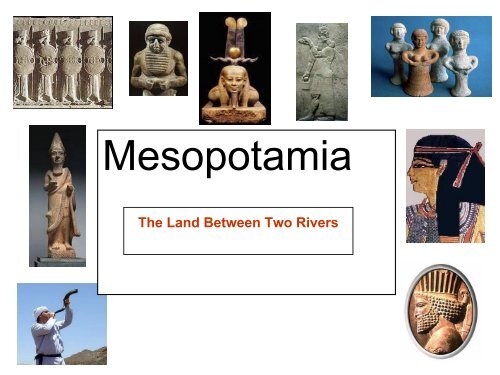
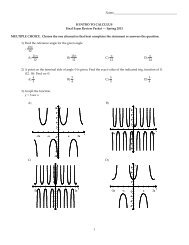
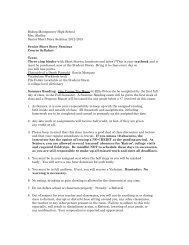
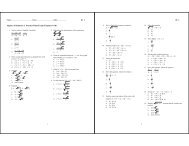
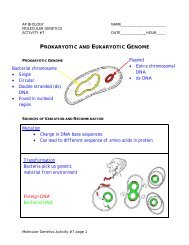
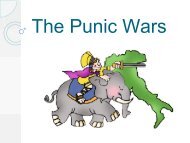
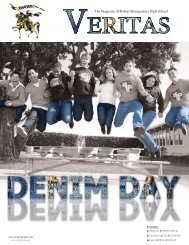
![1. Given: BD is tangent to circle O at C, , and m ACE [A] 41° [C] 40 ...](https://img.yumpu.com/42456754/1/190x245/1-given-bd-is-tangent-to-circle-o-at-c-and-m-ace-a-41a-c-40-.jpg?quality=85)
